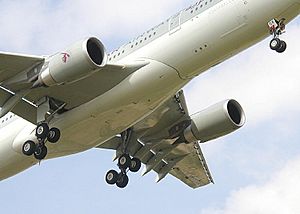Undercarriage facts for kids
The undercarriage or landing gear is a super important part of an aircraft. It's like the legs and feet of an airplane! This special structure helps the plane move safely on the ground. It supports the aircraft when it's not flying. Landing gear also helps planes take off and land smoothly. Most of the time, landing gear uses wheels. But some aircraft use skis or floats for different surfaces.
Contents
Why Do Planes Need Landing Gear?
Planes need landing gear for several key reasons. First, it holds the aircraft up when it's on the ground. This keeps the wings and body from touching the runway. Second, it allows the plane to roll. This is how planes move from the terminal to the runway. It also helps them slow down after landing. Third, landing gear absorbs the shock of landing. This makes sure the landing is smooth and safe for everyone inside. Without it, landings would be very bumpy!
How Does Landing Gear Work?
Landing gear is designed to be strong and flexible. It has special parts that absorb impact. These parts are called shock absorbers. They work like giant springs and pistons. When a plane lands, the shock absorbers compress. This takes away the force of the landing. It protects the aircraft's structure.
Many large planes have retractable landing gear. This means the gear can be pulled up into the plane's body. It happens after takeoff. This makes the plane more aerodynamic. It helps the plane fly faster and use less fuel. Before landing, the gear is lowered again. Small planes often have fixed landing gear. This gear stays down all the time.
Retracting and Extending Gear
When a pilot retracts the landing gear, it folds up. It goes into special compartments in the wings or body. Hydraulic systems usually power this movement. These systems use fluid pressure to move parts. Lights in the cockpit tell the pilot if the gear is up or down. They also show if it's locked in place. This is very important for safety.
Types of Landing Gear
Landing gear comes in different forms. The type depends on the aircraft and its purpose.
Wheeled Landing Gear
This is the most common type. It uses wheels, just like a car. Most airplanes, from small Cessnas to huge jumbo jets, use wheels. The wheels allow the plane to roll on runways. They are often made of strong rubber and metal.
Tricycle Gear
Most modern planes use tricycle gear. This means there's one wheel or set of wheels at the front. This is called the nose gear. Then there are two main sets of wheels under the wings. This setup makes it easy to steer on the ground. It also gives the plane good stability.
Conventional Gear (Taildragger)
Older planes often have conventional gear. This is also called "taildragger" gear. It has two main wheels near the front. A smaller wheel or skid is at the back under the tail. These planes can be harder to steer on the ground. But they are good for rough landing strips.
Ski Landing Gear
Some planes are designed to land on snow or ice. They use skis instead of wheels. These skis are wide and flat. They help the plane glide over snowy surfaces. This type of gear is common in colder regions. It's used for planes that fly to remote, snowy areas.
Float Landing Gear
Planes that land on water use floats. These are like long, hollow boats. They attach under the plane's body. Floatplanes can land on lakes, rivers, or the ocean. They are often used for transport in areas with many waterways. Some planes can even have both wheels and floats!
Parts of Landing Gear
Landing gear is made of several important parts. Each part has a special job.
Wheels and Tires
The wheels and tires are crucial. They support the plane's weight. They also provide grip on the runway. Aircraft tires are very strong. They can handle huge weights and high speeds. They are filled with nitrogen gas. This helps them stay stable at different temperatures.
Struts and Shock Absorbers
Struts are the main legs of the landing gear. They connect the wheels to the aircraft. Inside the struts are the shock absorbers. These are like giant springs and pistons. They cushion the landing. They also absorb bumps during taxiing. This makes the ride smooth.
Brakes
Planes need powerful brakes. They help the aircraft slow down after landing. Aircraft brakes are usually on the main wheels. They use friction to stop the wheels from turning. Modern planes often have anti-lock braking systems. These prevent the wheels from skidding. This helps the plane stop safely, even on wet runways.
Steering System
The nose wheel (or tail wheel) has a steering system. This allows the pilot to guide the plane on the ground. It works with pedals in the cockpit. The pilot can turn the wheel left or right. This helps the plane move to the correct runway or gate.
Landing Gear Safety
Landing gear is checked very carefully. Mechanics inspect it often. They look for any damage or wear. Pilots also check the gear before every flight. They make sure it's working correctly. Landing gear failure is very rare. But if it happens, pilots are trained to handle it safely. They can use emergency systems to lower the gear. Safety is always the top priority in aviation.


